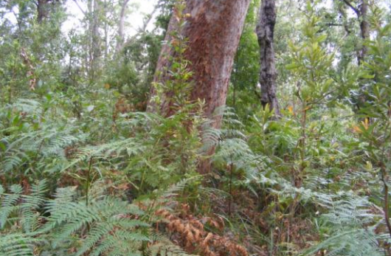Australia is home to many thousands of plants and animals. Many species are found only in Australia; 85% of flowering plants; 82% of mammals; 89% of reptiles and about 93% of our frog species are unique to this country. (Lindenmayer, 2007, p.33)
Bushland areas are an integral part of the biodiversity of our rural and urban landscapes, providing habitat for many native animals – from kangaroos and koalas to butterflies and beetles. Bushland also plays an important role in reducing the effects of global warming and controlling subtle changes to the local climate, and reduces the greenhouse effect by absorbing carbon dioxide from the atmosphere.
Bushland provides important areas for recreation, tourism and education. Its biological diversity is highly valued by the community and helps define our cultural identity and heritage.
Bushland areas are also important for the local, regional and national economy. The bush provides environmental services such as protecting water quality, stopping erosion, acting as a windbreak, producing oxygen and trapping nutrients. The CSIRO has estimated that environmental problems caused by vegetation loss costs Australia $1.4 billion in lost revenue each year. (LMCC Managing our Bushland Fact Sheet, 2012)
Nature conservation/ habitat
By planting and conserving local native plants we directly contribute to the conservation of the flora of the local area. As many species of birds, mammals, reptiles and other fauna are dependant on local vegetation we can also contribute to habitat conservation.
Heritage
Native bushland often contains Aboriginal artefacts. Paintings, rock engravings, axe grinding grooves, middens, tools and caves dwellings are all present in local bushland. They all act as reminders of Aboriginal history. Native bushland also contains many reminders of early European settlement.
Scenic/ recreational/ psychological
Native bushland has an irreplaceable scenic value by diluting the visual clutter of our cities. Furthermore, the character of our landscape is provided largely by the local native vegetation.
Recreational use of bushland is often overlooked as it usually does not involve large groups. Activities include orienteering, abseiling, rock climbing, photography, painting, plant identification, bird watching, bushwalking and outdoor family adventures such as picnics or barbecues. Children tend to be specialist users of the bush and should be treated as a unique group for whom the bush is a world of adventure and daring physical achievements.
Native bushland and natural settings provide a sense of ‘well-being’ and the feeling of ‘getting away from it all’.
Environmental
Native bushland contributes to ‘ecosystem services’ such as providing our food and many industrial products and medicines. Also bushland contributes to generating clean air, water and fertile soils through the processes of millions of interacting organisms that live in the air, water and soil. Basically, bushland contributes to ensuring the ongoing evolution of life on Earth.
Economic
Natural areas are a main source of economic income. A healthy environment rich in biodiversity is more productive and ensures industries such as food, medicine, timber and tourism are maintained economically in the future.
Some specific industries related to native bushland in Australia include:
- Honey production $300 million annually
- Bushfood production $100 million annually
- Wildflower exports $30million annually
Tourism is one of the cornerstones of our economy. Our koalas attract so many international visitors to Australia that they’re worth over a billon dollars annually to the economy.
Scientific/ educational
Native bushland provides opportunities for learning about the local environment.
Legal/ moral
We have legal and moral obligation to provide intergenerational equity.
(See Lindenmayer, 2007, pp.21-28; Ralph, 2003, pp.2-3; Buchanan, 1989, pp.1-4)
It is important to retain large patches of bushland and to join patches with corridors. Many species need patches of 100 hectares or more to sustain their populations. Some plants and animals can survive in smaller patches, but need connecting corridors to disperse seed, raise young, promote genetic diversity, escape fire, recolonise after fire and access a range of habitats.
Specialised vegetation communities – wetlands, rainforests, streambank, foreshore and coastal – perform very important environmental roles, even in small patches. For example, they stabilise dunes, protect creek banks and foreshores from erosion and shade water-bodies. They meet the special needs of fauna, for example by providing nesting and roosting trees. Specialised vegetation communities are particularly affected by human settlement.
(LMCC Managing our Bushland Fact Sheet, 2012)
Threats to bushland
Some of the key reasons why native bushland and therefore biodiversity is under threat:
- Size and shape of reserves
- Fragmentation
- Edge effects
- Weed invasion
- Rubbish dumping
- Altered fire regimes
- Soil erosion/ disturbance
- Climate change
Vegetation clearing, fragmentation and edge effects
Vegetation clearing – for agricultural, urban and industrial development – is perhaps the single most important cause of environmental degradation, loss of species, and depletion of ecological communities, both in Australia and worldwide.
Over the decade 1990-2000, Australia had the sixth highest annual rate of land clearing in the world. Notably, Australia is the only country in the top 20 land-clearing nations with a developed first world economy. More than 550,000 hectares of native vegetation are cleared in Australia each year.
(Lindenmayer & Burgman, 2005, p. 229-230)
Vegetation clearing leads to habitat loss, fragmentation, sub-division and isolation. This habitat loss and fragmentation typically results in a decrease in the average size of habitat patches, increase in the distance between them, a decrease in connectivity between patches, and in an increase in the edge to size ratio.
(See Lindenmayer & Burgman, 2005, pp. 255-292)
Basically, this loss of vegetation decreases native fauna biodiversity through the loss of habitat for breeding, nesting and feeding and increased competition for existing habitat areas.
(LMCC Biodiversity Fact Sheet, 2012)
In general the smaller the size of an area (or bushland patch) the fewer species, and the fewer of each species, it will maintain. Small patch size and long distances between patches are the cause of local extinctions, sometimes to such a degree that formally common species are now rare or threatened.
Natural areas that are square or round are comparatively easy to manage as they have a low edge to area ratio. Long thin natural areas have a high edge to area ratio and the ‘edge affect’ caused by surroundings will have a high impact.
(Buchanan, 2009, p.17)


